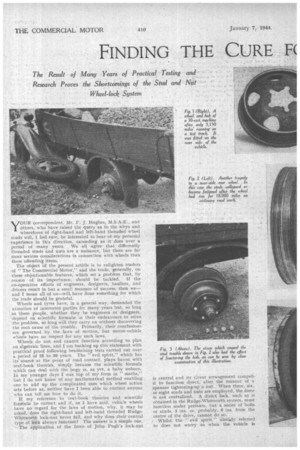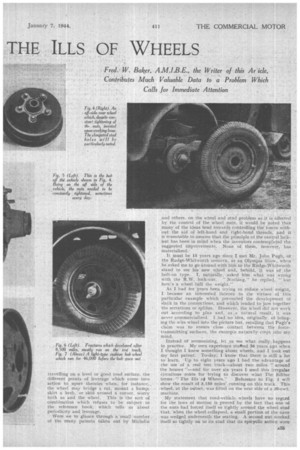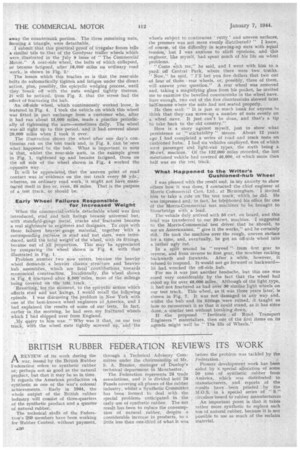FINDING THE CURE R
Page 26

Page 27

Page 28

If you've noticed an error in this article please click here to report it so we can fix it.
THE ILLS OF WHEELS-..
yOUR correspondent, Mr. F. J. Hughes, M.S.A.E., and Others, who have raised the citlery.as to the whys and wherefores of right-hand and left-hand threaded wheel studs will, I feel sure, be interested to bear' of My 'personal experience in this direction, extending as it does over a period of many years. We all agree that differently threaded studs and nuts are a nuisance, hilt there are far more serious considerations in connection with wheels than these offending items.
The object Of the present article is to enlighten readers of " The Commercial Motor," and the trade, generally, on these objectionable features, which set a problem that, by reason of its importance, • should be tackled. If the co-operative efforts of engineers, designers, hauliers, and drivers result in but a small measure Of success, then we— and I mean all of us—will, have done something for which the trade should be grateful.
Wheels and tyres have, in a general way, demanded the attention of interested parties for many years but, so long as these people, whether they be engineers or designers, depend on scientific formula in their endeavours to solve the problem, so long will they carry on without discovering the root cause of the trouble. Primarily, their conclusions' are governed by the laws of motion, but motor-vehicle wheels have no respect for any such laws. Wheel's do not and cannot function according to plan on algebraic lines, and I am backing up this statement with practical proof following headaching testS carried out over a period of 25 to 30 years. The " evil spirit," which has its' source at the point of rdad contact, plays havoc with text-book theories, simply because the scientific formula which can deal with the bogy is, as yet, a baby unborn. in my younger days I was top of my form in" maths," but I do not knOw Of any mathematical method enabling one to add up the complicated sum whiCh wheel action sets before us, neither have I been able to contact anyone who can tell me how to do it.
If my reference to text-book theories and scientific forniuhe be correct and if, as I have said, vehicle wheels have no regard for the laws of motion, why, it may be asked, does the right-hand and left-hand threaded RudgeWhitworth lock-nut never fail, and why does their central type ofloCk always function? The answer is a simple one. The application of the force of John Pugh's lock-nut is central and its clever arrangement compels it to function direct, after the manner of a spanner tightening-up a nut. When three, six. or eight studs and nuts are employed,' the force is not centralized. A direct lock, such as is obtained in the Rudge-Whitworth system, must function under prasure, but a series of bolts or studs, 3 ins. or, probably, 6 ins, from the centre of the drive, cannot do so.
Whilst the '' evil spirit " alreuly referred to does not worry us when the vehicle is
travelling on a level or good road surface, the different points of leverage whichcome into action to upset theories when, for instance„ the wheel may bridge a rut; mount a hump; skirt a kerb, • or skid around a corner, worry both us and the wheel, This is the sort of • combination which refuses to be subject to the reference book, which tells us about .
periodicity and leverage. • Were we to glance through a •small number. of the many patents taken out by Michelin
and others, on the wheel and stud problem as it is affected by the control of the wheel nuts, it would be noted 'that many of the ideas tend towards controlling the forces without the aid of left-hand and right-hand threadS, and it is reasonable to assume that.the principle of the central locknut has beenin mind when the inventors contemplated the suggested iniprovements. None of them, however, has
Materialized. ,
It must be 15 years ago since I met Mr. John Pugh, of the Rudge-Whitworth concern, at an Olympia Shotv, when he asked me to go around with him to the Ruclge-Whitworth stand to see his new Wheel arid, behold, it was of the bolt-on type. I, naturally, asked him what was wroirg with the R.W. lock-nut. " Nothing," he -replied, " but here's a wheel.liall the weight."
As I had for years been trying to reduce wheel weight. I became an interested listener to the virtues of this particular example which prevented the development of , slack in the connections, and which tended to jam together the serrations or splines. However, the wheel did not work Out according to plan and, as ,a natural result, it was never commercialized. I had no idea, originally, of bringing the wire wheel into the picture hut, recalling that Pugh's claim was to ensure close contact between the forcetransmitting surfaces, the example naturally crept into my mind. , •
Instead of sermonizing, let us 'see what really happens in practice. My own experience staPted 36 yeats, ago when I thought I knew something about wheels, and. I took out my first patent.. To-day; I know that there is still a lot to learn. Up to eight years ago I had the' advantage of the use of a real test, track—about two miles " around the houses "—and for over six -years Iused this irregular circuitous route for trying to discover what Tire Editor
terms " The Ills oi Wheels." Reference to Fig. 1 will show the result of 3,150 miles' running on this track. This • wheel, at the outset, was fitted on the 'near side of a 30-cwt. machine.
My statement that road-vehicle, wheels have no regard ' for the laWs of motion is proved by the fact that one of the nuts had forced itself so tightly around the wheel stud that, when the Wheel collapsed, a small portion of the nave . was wedged underneath the seating. A second nut worked itself so tightly on to its stud that its epicyclic action wore A25 away the countersunk portion. The three remaining nuts, forming a triangle, were detachable.
I submit that this practical proof of irregular forces tells a similar tale to that of the Goodyear trailer wheels which were illustrated in the July 8 issue of " The Commercial Motor." A near-side wheel, the bolts of which collapsed, or became fatigued, after 18,000 miles on ordinary road work, is shown in Fig. 2: , The lesson which this teaches us is that the near-side bolts do automatically tighten and fatigue under the direct action, phis, possibly, the epicyclic wedging process, until they break off with the nuts wedged tightly thereon. It will be noticed, krom Fig. 3, that the stress had the effect of fracturing the hub.
An off-side wheel, which continuously worked loose, is featured in Fig. 4. I took the vehicle oil which this wheel was fitted in part exchange from a customer who, after it had run about 15,000 miles, made a ,practice periodically of tightening the nuts--sometimes daily. The wheel was all right up to this period, and it had covered about 20,000 miles when I took it over.
The illustration shows the wheel after one day's continuous run on the test track and in Fig. 5, can be 'seen what happened to the hub. What is important to note is that, whilst the near-side nuts, in the example given in Fig. '1, tightened up and became fatigued, those on the off side of the wheel shown in Fig. 4 worked the opposite way, .
It will be appreciated, that the uneven point of road contact was in evidence on the test track every 56 yds., whereas, on ordinary road work, it might not have manifested itself in five or, even, 55 miles. That is the purpose of a test track, or should be.
Early Wheel Failures Responsible for ,increased Weight When the conimercial-vehiele detachable Wheel was first introduced., stud and bolt fixings became universal but, with standard gauge metal,, cracks and 'fractures became a real nightmare to engineers and designers. To cope with these failures heavier gaugematerial, ' together With a corresponding increase in stud and nut sizes, were introduced, until the total weight ofthe wheel, with its fittings, became out of all proportion. This may be appreciated by comparing the wheel shown in Fig. 6, with that illustrated in Fig. L .
Problem number two now enters, because the heavier wheel demands a heavier chassis structure and heavier hub assemblies, which are fatal contributions towards economical construction. _Incidentally, the wheel shown in rig fractured after 8,500'miles, most of the mileage being covered on the teit, trick, Reverting,. for the moment, to the epicyclic action which affects stud and nut fixings I would recall the following episode. I was discussing the problem in New York with one of the best-known wheel engineers of America, and I had explained the results of some of our tests. In fact, earlier in the morning, he had seen my fraCtured wheels which I had shipped over from England.
,My query to him was; " Why was it that, on our test track, with the wheel nuts tightly screwed up,' ancl the
wheels subject to continuous rutty ' and uneven surfaces, the pressure was not more evenly distributed? " I knew, of course, of the difficulty in screwing-up nuts with equal tension, but I was anxious to elicit opinions, and this engineer, like myself, had spent much of his life on wheel problems. ,
" Come with ,me," he said, and I went with him to a yard off Central Park, where there were two trucks. " Now," be said, " Ill bet you fivedollars that two out of four of those rear wheels, or, possibly, three of them. Will answer your question." A rear wheel was removed and, taking a magnifying glass from his pocket, lie invited me to examine the bevelled countersinks in the wheel nave. Sure enough, two out of the five Countersinks showed faint half:moons' where the nuts had not seated properly.
He then said: ." It is just so much bunk for anyone to think that they can screw-up a number of nuts evenly on a wheel nave. It just can't be done, and that's a tip to take back to the old country."
Here is a story against myself, just to show what persistence or " stickability " Means. About 12 years ago .I had completed a series of road and track tests on cushioned hubs.. I had six vehicles employed, 'five of which were passenger and light-van types; the sixth being a 30-cwt. machine. ' Of the 132,000 miles recorded, the last mentioned vehicle had coverecI46,000, of which more than half was on the test track.
What Happened to the Writer's • Cushioned-hub Wheel
I was pleased with the result and. in My anxiety to show others bow it waS done, I contacted the chief engineer of Morris Commercial Cars, Ltd., at Birmingham. I invited him to take a ride"on the test traek, whin he did. He was impressed and; in fact; he teleblioned his office for one of the Morris-Commercial test machines to. be brought to Stourbridge with ,a load.
The vehicle duly arrived with 50 cwt. on board, and this load was transferred to our a0,cwt: machine. I suggested to the Morris-Commercial test driver, that he .should, to use an Americanism, "give 'it the works," and he certainly did. He took the machine over the rough, uneven surface for a time, and, eventually, he got an off-side wheel into a rather ugly rut.
In a split second he " revved ". from first gear to reyerse, and from reverse to first gear, the machine rocking backwardS and forwards. After. a .while, however, it refused th respond. It would not go forward or backward— lie had. wrecked the off-side. hub.
For me it was just another headache, but this one was eased very considerably by the fact that the wheel had stOod up for over 46,000 miles. Although of the light type, it had not fractured as had over 30 similar 'light wheels on our test track This wheel, as it w-a,s three years later.; is shown in Fig. 7. It was not damaged in any way and, whilst the hub and its ,fittings were ruined, it taught us how to reconstruct it so that it could stand, as it has since done, ,a similar test without breaking down.
If -the proposed " Institute of Road Transport Engineers " materializes, then one of the first items on its agenda might well be " Ills of Wheels."




















































